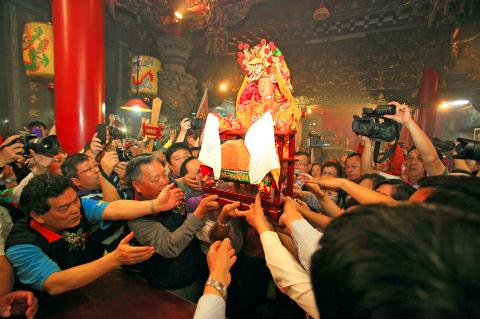On March 16th, on the stroke of half past midnight, a palanquin holding a centuries-old Matsu statue, newly washed and dressed, will leave the Gong Tian Temple (拱天宮) in Baishatun (白沙屯), Miaoli County.
Who chose that date? The goddess did. Why leave at such an ungodly hour? That, too, was Matsu’s decision.
The 11-day pilgrimage will take in a 200km round trip to Chao Tian Temple (朝天宮) in Beigang (北港), Yunlin County, and back. The arrangements, says the temple’s current director, Chen Chun-fa (陳春發), are 70 percent decided by the goddess, 30 percent by the temple committee.

Photo courtesy of the Baishatun Matsu Web site
Chen says the committee wanted an early morning start to let the pilgrims get some sleep, but no matter how many times they cast lots it was “no” for a morning start.
“We always go according to what Matsu wants.”
The Baishatun pilgrimage, the earliest “pedestrian” Matsu pilgrimage in Taiwan, started over 200 years ago, with perhaps 20 pilgrims, Chen says. Today pilgrims come from all over Taiwan, and from Japan. When Chen first attended in 1971, there were some 300 pilgrims. There were no more than 3,000 when he joined the temple 15 years ago.

Photo courtesy of the Baishatun Matsu Web site
“It has increased yearly since then and ballooned in the last few years. Last year 19,000 people registered; 15,000 have already registered for this year’s event.”
Unlike the Dajia (大甲) pilgrimage, the route is unknown.
“Lots of police ask us, but we can only tell them that we simply don’t know,” Chen said.
MATSU’S WHIM
Matsu will tell the bearers her preferred direction whenever they come to junction. In 1978, Matsu decided not to cross the Xiluo Bridge (西螺大橋), and insisted on going underneath, where they chanced upon a family living in a ramshackle hut by the river. The palanquin swayed, lots were cast, and it was discovered Matsu was saying the family should move before the Dragon Boat Festival.
The family moved, heavy rains swelled the river, the shack was swept away.
Neither does the goddess necessarily allot to stay overnight at a temple. Thirty years ago the palanquin stayed at a house in Xiluo. It entered via the front door without problem, but the next morning the owner had to dismantle the doorway to get the palanquin out.
“That year he made a lot of money,” Chen said, referring to the popular notion that if you do Matsu a favor, she will reward you.
For a registration fee of NT$700, pilgrims receive clothes, a hat, a talisman, a mention to Matsu and their name read out by Chao Tian Temple priests before the pilgrimage returns from Beigang. You cannot register online; send money and info including your name and size via registered post, and on the day of the pilgrimage you can pick up your goodies from the temple.
You don’t need to register to participate.
If you fancy attending some or all of the route, it leaves the temple, near Baishatun train station in Miaoli County, at 12:30am on Wednesday, arriving in Beigang on March 20 and arriving back in Baishatun on March 26.
Food and water are provided free along the route. Bring sunscreen, mosquito repellent, talcum powder and consider a tent. Be prepared for huge crowds.
— additional reporting by louis jia-yu wei

This month the government ordered a one-year block of Xiaohongshu (小紅書) or Rednote, a Chinese social media platform with more than 3 million users in Taiwan. The government pointed to widespread fraud activity on the platform, along with cybersecurity failures. Officials said that they had reached out to the company and asked it to change. However, they received no response. The pro-China parties, the Chinese Nationalist Party (KMT) and Taiwan People’s Party (TPP), immediately swung into action, denouncing the ban as an attack on free speech. This “free speech” claim was then echoed by the People’s Republic of China (PRC),

Exceptions to the rule are sometimes revealing. For a brief few years, there was an emerging ideological split between the Democratic Progressive Party (DPP) and Chinese Nationalist Party (KMT) that appeared to be pushing the DPP in a direction that would be considered more liberal, and the KMT more conservative. In the previous column, “The KMT-DPP’s bureaucrat-led developmental state” (Dec. 11, page 12), we examined how Taiwan’s democratic system developed, and how both the two main parties largely accepted a similar consensus on how Taiwan should be run domestically and did not split along the left-right lines more familiar in

Many people in Taiwan first learned about universal basic income (UBI) — the idea that the government should provide regular, no-strings-attached payments to each citizen — in 2019. While seeking the Democratic nomination for the 2020 US presidential election, Andrew Yang, a politician of Taiwanese descent, said that, if elected, he’d institute a UBI of US$1,000 per month to “get the economic boot off of people’s throats, allowing them to lift their heads up, breathe, and get excited for the future.” His campaign petered out, but the concept of UBI hasn’t gone away. Throughout the industrialized world, there are fears that

Most heroes are remembered for the battles they fought. Taiwan’s Black Bat Squadron is remembered for flying into Chinese airspace 838 times between 1953 and 1967, and for the 148 men whose sacrifice bought the intelligence that kept Taiwan secure. Two-thirds of the squadron died carrying out missions most people wouldn’t learn about for another 40 years. The squadron lost 15 aircraft and 148 crew members over those 14 years, making it the deadliest unit in Taiwan’s military history by casualty rate. They flew at night, often at low altitudes, straight into some of the most heavily defended airspace in Asia.